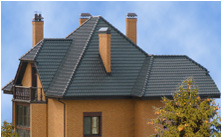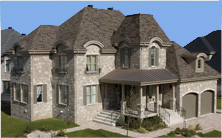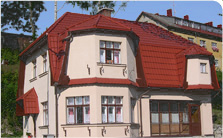Modern chimneys
Modern chimneys
 For virtually any type of heating stove that uses solid or liquid fuels, the main thing is not so much heating equipment as the same flue (to put it simply, a pipe or chimney), which puts out the smoke.
For virtually any type of heating stove that uses solid or liquid fuels, the main thing is not so much heating equipment as the same flue (to put it simply, a pipe or chimney), which puts out the smoke.
Smoke, Backdraft, and finally a fire - all this can happen as a result of irresponsible attitude to the chimney. That's why on its proper installation and quality depends on the efficiency of heating system, longevity, and finally, the security of your home. Pipes are made of brick, concrete, ceramics, but in this article focuses on stainless steel. Why the need for a chimney, like a clear-take the smoke, rather, products of combustion produced during combustion of fuel from the premises. More faithful to this definition: the smoke channel is designed to create a natural draft, outlet of furnace combustion products, which ensures the supply of it needed for combustion air. On how to properly arranged chimney and what materials are used to do this depends directly on the effectiveness and safety of the entire heating system. Somehow, most people completely fail to take into account the importance of the smoke channel. Hence the sad statistics: Ukraine occupies a leading position on the number of fires. And most of them are due to selection of low-quality components when constructing flues, non-compliance with fire safety requirements, errors in calculating the parameters of the tube. In addition, the chimneys need timely service, paying particular attention to the natural wear of the materials from which it is made.
Of what do chimneys ?
In ancient times, when the most popular heating device was a fire on the floor of the hut, used to vent smoke hole in the ceiling. Later the smoke from stoves and fireplaces were removed through special channels in the padded walls, or through separate chimneys. Soon the brick for many years to become the main material for production of chimneys. But the heating equipment is rapidly improving. Meeting the challenges of energy saving and environmental protection leads to more efficient heating units and reduce emissions of harmful substances. Therefore, the operating rules of modern stoves, fireplaces and boilers are placing more stringent requirements for chimneys and conditions of use.
Modern smoke channels should be strong and durable. They have to withstand high temperature flue gases, to provide smoke extraction at a reduced temperature of discharged gas, condensate, and resistant to corrosive acids, as well as to meet fire safety requirements. Currently, the once monopolistic brick was found a worthy replacement. As a material for chimneys are increasingly using metal tubes, especially of heat-resistant and acid resistant stainless steel. Stainless steel flue channels have less weight than the brick, and do not require additional foundation, they are much easier to mount, it's kind of easy to build a constructor, they are resistant to corrosion, durable, suitable for various modifications of boilers and furnaces.
Metal pipes are the best section for the removal of flue gases. In the flue ducts of circular cross section in contrast to the square and rectangular without local turbulence affecting the movement of the main flow of gases. On a perfectly smooth wall metal chimneys are not deposited soot. Steel pipes easily installed in already built houses, where the construction phase was not the option of installing heating units and, accordingly, there is no chimney. Metal pipes are widely represented in our market well-known foreign manufacturers. Began to produce steel pipes for chimneys and Ukrainian manufacturers. Some of them produce and modular flue channels (full set of required elements for the installation of chimneys every difficulty). Not inferior in quality to Western counterparts, the Ukrainian products are often much cheaper. Having all the advantages of steel chimney, they also differ in reliability and durability. These elements consist of an inner tube, the insulating layer on the basalt and the outer shell - made of galvanized or stainless steel must say that we have for the erection of flue channels still use asbestos-cement pipe. Unfortunately, this comes from poverty. It should be borne in mind that they are perfect for this purpose not intended. The fact that this material is carcinogenic, in which close their eyes lightly, and the most dangerous thing that the asbestos-cement pipe fire risks (especially when using them for fireplaces and saunas!). You should not put their lives at risk for the sake of questionable economy.
Thus, modern chimney systems have significant advantages over traditional brick. And thanks to its characteristics and versatility in a leading position in the now emerging steel flue channels, made of stainless steel. Its advantages over steel 3 ("black" steel) are obvious. Low corrosion resistance of the material leads to complete destruction of the smoke channel in a fairly short time. And his primary cheapness leads subsequently to a permanent additional investment. And a decent portion of these costs falls on reassembling the chimney. The more so because the smoke channel is made of stainless steel, reliable and, therefore, significantly increases the fire safety of the entire heating system.
There are two types of metal chimney - single-circuit and the bypass. With single-circuit is clear: this pipe and fittings in stainless steel or steel 3. They are cheap enough, and they are usually used for the construction of the smoke channel indoors or as inserts into existing masonry chimneys to protect the inner surface (in the latter case it is necessary to use pipes made of stainless steel).
Double-walled three-layered insulated pipes, the so-called sandwich, composed of the inner welded stainless steel pipes and the outer tube (shell) of larger diameter. Inside, they placed a layer of non-combustible insulating material based on basalt, which excludes the strong cooling of the flue gas and minimizes loss of aggressive condensate. Inner tube, made of quality stainless steel, takes on the impact of combustion products and aggressive media. Guaranteed brilliant performance, as it is resistant to burning, corrosion and acids. Lagger - Pressed mineral insulating material based on basalt rock. Basalt has a very low thermal conductivity and effective thermal insulation properties, which helps to minimize the formation of aggressive condensate. Material being used - environmentally friendly, contains no binder resin, and even at high temperatures, pipe insulation does not emit an unpleasant-smelling substances. The outer tube can be made of stainless steel (including decorative - the mirror, textured, colored), steel, or to reduce the cost structure - made of galvanized steel. Decorative stainless steel looks and effectively when installing a chimney inside the house blend seamlessly into the interior, and exterior installation. There are options for flue channels with the outer tube made of copper. They are commonly used in the historical city center. Some companies offer chimneys with outer steel tube covered with a heat-resistant enamel of different colors. Most often they are used as flues for stoves, fireplaces. Double-walled flue substantially improve the heating devices, increase the efficiency of the entire system, which contributes to more economical operation of heating units.
Modular chimney system.
For some reason, believe that the chimney - it is simply a tube or several tubes. But for the beginning of this pipe must be connected to the output of flue pipe stove (fireplace, boiler). Suddenly it turns out that it is directed horizontally. Immediately there is a problem changing the direction of the chimney: we need something vertical. Here come to the aid knee or tees. (At the tee, in contrast to the knee, if it provides an element cleaning - removable cup at the bottom or any other element audit - just easier to clean the flue channel.) Assume tee found the pipe is. But they also need to articulate among themselves. And not just as tightly, so that smoke does not take place at the joint. Therefore, they should just come together.
Go ahead. Suppose the chimney must pass through the second floor. But the pot is set so that the exit flue channel prevents any beam. It should be avoided. Again to change the direction of the chimney. No problem! There is a knee at different angles of rotation, such as knee angle of 45 °. Smoke turned the channel, skirted the obstacle, we continue to move. Or here it is, the overlap of the second floor - wood! How to pipe through it, which roam the hot flue gases? After all, maybe to flash. For this purpose there are special bushing tubes of larger diameter. Cut a hole in the ceiling, put-through tube, insulating and conducting the flue. And to pass on the second floor and exit to the roof, we take another pass pipe. Yes, even at the correct angle. Just keep in mind that the purpose of fire safety in places of passage through the ceiling of his chimney pipe must be joint with another pipe. If it turns out that the standard pipe does not allow to pass this place without a dock, do not worry. Everything is thought out! The set of modular flue pipe must be of shorter length. For example, a length of 1 m, and 50 or 25, see first becoming a short pipe, and then using a long tube quietly pass overlap.
Imagine that we withdraw the pipe outside the house. But she could not hang in the air by itself will fall. Therefore, must be strengthened. To do this every couple of meters of pipe is then attached to the wall wall bracket required diameter. We need to bring the pipe through the roof. This raises the perennial problem: how to make it leak out that the precipitation does not penetrate into the house. That just do not do! Plug the holes with anything. Close up the gap fire-resistant sealant, but it hardens, and the house shrinks - and everything fell apart again, and again from the top dripping. Refuse to pass through the roof and display the chimney outside the house (the most successful in this case the option). But again, there is a decent solution: a modular system provides an element such as a roof cutting. This is a conical tube with welded under roof sheets. Typically, roof cutting designed to appropriate roof angle: 0 °, 5-20 °, 35-55 °, and so forth. Thanks to the taper roof Cutting fix the desired angle roof, and under roof sheet is slid under the ridge or at the nearest upper seam roofing material. Flue pipe goes through the roof cutting and the top (in the narrowest part of the conical tube roof cuts) its corresponding seal apron-clamp. Now the fallout is not afraid! We reviewed the basic elements of modular chimney. It is clear that this survey does not list all items offered by manufacturers. But hopefully the reader will understand what exactly is a modular system and why such chimneys are particularly popular. Provided virtually all mounting options. Elements are compact, simple design, convenience, ease of assembly and the relatively low price. And, importantly, the quality of production - all goes well, all joints. Our company offers single-and double-walled (sandwich) chimney systems of various sizes that can make the best choice smoke channel specifically for your heating system. The composition of the necessary elements for the construction of a concrete chimney is adjusted depending on the arrangement and construction of the building.
Installation and placement options chimney.
Installation of double-walled chimney should start from the bottom (of the heating system) up. When installing the inner tube further element must be a member inside the tube last. This is to ensure that emerging condensate or falling into the chimney precipitation remained inside the pipe smoke channel and did not fall on the mineral wool insulation. Outer tube (casing), in turn, make sure that the previous one, so that nothing fell into the inner layer of the chimney. Pipes skewer one another. Depending on the design elements of the vendor-specific docking sites can be sealed or the relevant clips or by tapered tubes. For better sealing of pipes is desirable to use the sealant with an operating temperature of at least 1000 ° C for fireplaces and 300 ° C for boilers. The joints of pipes with other elements of (tees, elbows, etc.) should brace clamps. Recall that for every two-meter chimney should be installed to the mounting bracket stene.U chimney oven can not do horizontal segments longer than 1 m. When passing through the flue channel through walls, ceilings or roofs should be used through-connections are made in accordance with the standards of fire safety. Chimneys should not come into contact with electrical wiring, gas pipelines and other utilities. The minimum height for a furnace flue channel - not less than 5 m (and if considered in relation to a particular house, the height of the chimney should be at least 0,5 m above the ridge. The final cost depends on the diameter of the flue channel, its height and the concrete scheme of its construction. This later should still add the cost of installation. With regard to installation of the installation of the heating unit and erection of a chimney for him, then it should be noted that any heating device - a complicated and fire the device, so it is advisable to apply to professional firms with relevant experience and responsible for the quality of their work. Experienced professionals will help you choose a product with all the possible wishes, prepare a project and figure out all of its constituents, acquire or make all the necessary elements, will work on installation, hand over a working system, prompt, determine the rules of operation and, naturally, will guarantee on their work.





